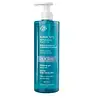What's inside
What's inside
 Key Ingredients
Key Ingredients

 Benefits
Benefits

 Concerns
Concerns

 Ingredients Side-by-side
Ingredients Side-by-side

Water
Skin ConditioningZinc Coceth Sulfate
CleansingCeteareth-60 Myristyl Glycol
EmulsifyingGlycerin
HumectantLauryl Betaine
CleansingDecyl Glucoside
CleansingPolysorbate 20
EmulsifyingTrideceth-9
EmulsifyingCI 42090
Cosmetic ColorantCitric Acid
BufferingParfum
MaskingGlyceryl Laurate
EmollientMyrtus Communis Leaf Extract
PerfumingPEG-40 Hydrogenated Castor Oil
EmulsifyingPEG-5 Ethylhexanoate
EmulsifyingPPG-26-Buteth-26
Skin ConditioningSodium Benzoate
MaskingSodium Chloride
MaskingSodium Hydroxide
BufferingTrisodium Ethylenediamine Disuccinate
Water, Zinc Coceth Sulfate, Ceteareth-60 Myristyl Glycol, Glycerin, Lauryl Betaine, Decyl Glucoside, Polysorbate 20, Trideceth-9, CI 42090, Citric Acid, Parfum, Glyceryl Laurate, Myrtus Communis Leaf Extract, PEG-40 Hydrogenated Castor Oil, PEG-5 Ethylhexanoate, PPG-26-Buteth-26, Sodium Benzoate, Sodium Chloride, Sodium Hydroxide, Trisodium Ethylenediamine Disuccinate
Water
Skin ConditioningGlycerin
HumectantSodium Acrylate/Sodium Acryloyldimethyl Taurate Copolymer
Emulsion StabilisingPolysorbate 80
EmulsifyingHydrogenated Lecithin
EmulsifyingDimethyl Isosorbide
SolventIsohexadecane
EmollientTocopherol
AntioxidantBisabolol
MaskingTrehalose
HumectantBetaine
HumectantSodium PCA
HumectantUrea
BufferingPalmitoyl Hydroxypropyltrimonium Amylopectin/Glycerin Crosspolymer
Skin ConditioningHydroxypinacolone Retinoate
Skin ConditioningAloe Barbadensis Extract
Skin ConditioningButylene Glycol
HumectantLecithin
EmollientPapain
Skin ConditioningRetinol
Skin ConditioningDehydroacetic Acid
PreservativeGlucose
HumectantGlycine Soja Oil
EmollientSorbitol
HumectantPolysorbate 20
EmulsifyingFructose
HumectantAscorbyl Palmitate
AntioxidantMaltodextrin
AbsorbentGlycine
BufferingCitric Acid
BufferingPhenoxyethanol
PreservativeLactic Acid
BufferingSodium Hydroxide
BufferingPotassium Hydroxide
BufferingHydrolyzed Wheat Protein
Skin ConditioningBenzyl Alcohol
PerfumingSodium Glutamate
MaskingBeta-Sitosterol
Emulsion StabilisingSqualane
EmollientMalic Acid
BufferingGlycolic Acid
BufferingTartaric Acid
BufferingLysine
Skin ConditioningMethylparaben
PreservativeEthylparaben
PreservativeButylparaben
MaskingWater, Glycerin, Sodium Acrylate/Sodium Acryloyldimethyl Taurate Copolymer, Polysorbate 80, Hydrogenated Lecithin, Dimethyl Isosorbide, Isohexadecane, Tocopherol, Bisabolol, Trehalose, Betaine, Sodium PCA, Urea, Palmitoyl Hydroxypropyltrimonium Amylopectin/Glycerin Crosspolymer, Hydroxypinacolone Retinoate, Aloe Barbadensis Extract, Butylene Glycol, Lecithin, Papain, Retinol, Dehydroacetic Acid, Glucose, Glycine Soja Oil, Sorbitol, Polysorbate 20, Fructose, Ascorbyl Palmitate, Maltodextrin, Glycine, Citric Acid, Phenoxyethanol, Lactic Acid, Sodium Hydroxide, Potassium Hydroxide, Hydrolyzed Wheat Protein, Benzyl Alcohol, Sodium Glutamate, Beta-Sitosterol, Squalane, Malic Acid, Glycolic Acid, Tartaric Acid, Lysine, Methylparaben, Ethylparaben, Butylparaben
Ingredients Explained
These ingredients are found in both products.
Ingredients higher up in an ingredient list are typically present in a larger amount.
Citric Acid is an alpha hydroxy acid (AHA) naturally found in citrus fruits like oranges, lemons, and limes.
Like other AHAs, citric acid can exfoliate skin by breaking down the bonds that hold dead skin cells together. This helps reveal smoother and brighter skin underneath.
However, this exfoliating effect only happens at high concentrations (20%) which can be hard to find in cosmetic products.
Due to this, citric acid is usually included in small amounts as a pH adjuster. This helps keep products slightly more acidic and compatible with skin's natural pH.
In skincare formulas, citric acid can:
While it can provide some skin benefits, research shows lactic acid and glycolic acid are generally more effective and less irritating exfoliants.
Most citric acid used in skincare today is made by fermenting sugars (usually from molasses). This synthetic version is identical to the natural citrus form but easier to stabilize and use in formulations.
Read more about some other popular AHA's here:
Learn more about Citric AcidGlycerin is already naturally found in your skin. It helps moisturize and protect your skin.
A study from 2016 found glycerin to be more effective as a humectant than AHAs and hyaluronic acid.
As a humectant, it helps the skin stay hydrated by pulling moisture to your skin. The low molecular weight of glycerin allows it to pull moisture into the deeper layers of your skin.
Hydrated skin improves your skin barrier; Your skin barrier helps protect against irritants and bacteria.
Glycerin has also been found to have antimicrobial and antiviral properties. Due to these properties, glycerin is often used in wound and burn treatments.
In cosmetics, glycerin is usually derived from plants such as soybean or palm. However, it can also be sourced from animals, such as tallow or animal fat.
This ingredient is organic, colorless, odorless, and non-toxic.
Glycerin is the name for this ingredient in American English. British English uses Glycerol/Glycerine.
Learn more about GlycerinPolysorbate 20 is made by combining ethoxylation of sorbitan, ethylene oxide, and lauric acid. It is a mild cleansing agent, surfactant, and emulsifier.
As a surfactant, it helps collect dirt and oils for washing. Emulsifiers prevent oils and water from separating.
Polysorbate 20 also adds scent to a product. Since it is made using sorbitol, it has a sweet scent. Sorbitol can also be found in fruits such as apples and peaches.
The lauric acid used to create Polysorbate 20 is often derived from coconuts.
Polysorbate 20 may not be fungal acne safe.
Learn more about Polysorbate 20Sodium Hydroxide is also known as lye or caustic soda. It is used to adjust the pH of products; many ingredients require a specific pH to be effective.
In small amounts, sodium hydroxide is considered safe to use. However, large amounts may cause chemical burns due to its high alkaline.
Your skin has a natural pH and acid mantle. This acid mantle helps prevent harmful bacteria from breaking through. The acid mantle also helps keep your skin hydrated.
"Alkaline" refers to a high pH level. A low pH level would be considered acidic.
Learn more about Sodium HydroxideWater. It's the most common cosmetic ingredient of all. You'll usually see it at the top of ingredient lists, meaning that it makes up the largest part of the product.
So why is it so popular? Water most often acts as a solvent - this means that it helps dissolve other ingredients into the formulation.
You'll also recognize water as that liquid we all need to stay alive. If you see this, drink a glass of water. Stay hydrated!
Learn more about Water